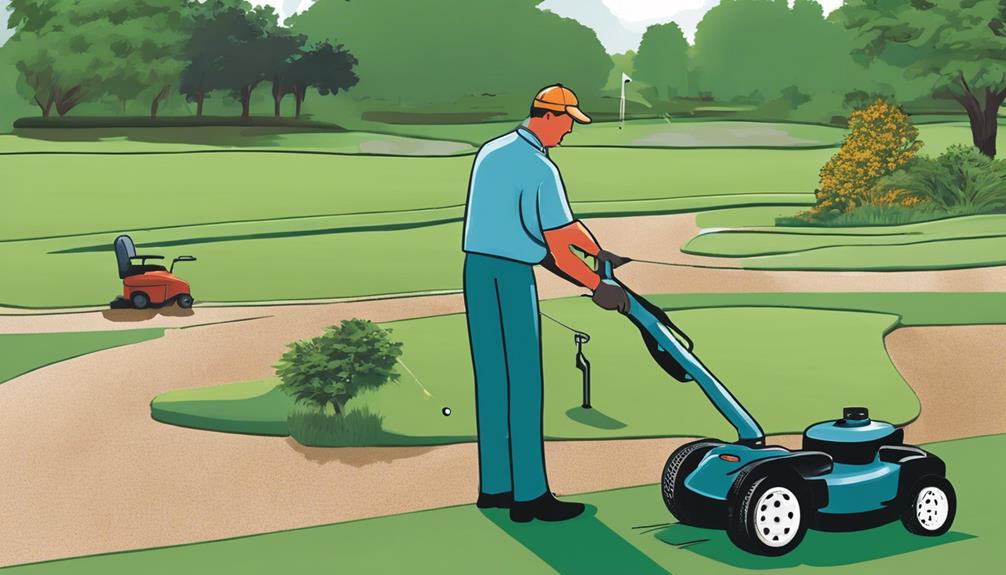7 Essential Tips for Maintaining a Healthy Golf Course
Ever wondered how top golf courses maintain their lush greens and pristine fairways? Behind the scenes, there are key strategies at play that you might not be aware of. Ensuring the health of a golf course involves much more than meets the eye.
By following these essential tips, you can elevate the quality of your course and provide players with an optimal experience. Stay tuned to discover the secrets to a thriving and visually stunning golf course.
Implement Proper Irrigation Techniques
To ensure your golf course stays lush and healthy, consistently assess and adjust your irrigation methods for optimal results. Water conservation and efficiency are crucial aspects of sustainable landscaping practices that you should prioritize. Implementing proper irrigation techniques not only benefits the environment but also helps maintain the beauty and playability of your golf course.
One key practice for water conservation is to use smart irrigation systems that adjust water flow based on real-time weather conditions and soil moisture levels. These systems can significantly reduce water waste by ensuring that your turf receives just the right amount of water it needs. Additionally, consider incorporating drought-resistant grass varieties into your course design. These grasses require less water, promoting water efficiency while still providing a vibrant green playing surface.
Regularly monitoring your irrigation system for leaks or malfunctions is essential for maintaining efficiency. Even small leaks can lead to significant water loss over time. By promptly addressing these issues, you can prevent unnecessary water waste and keep your water usage in check.
Regularly Monitor Soil Quality
Regularly monitoring the quality of your golf course's soil is essential for ensuring optimal health and performance. Soil testing allows you to understand the nutrient levels and pH balance of the soil, helping you make informed decisions about necessary adjustments for maintaining a healthy turf.
Here are some key points to consider regarding soil quality:
- Soil Testing: Conduct regular soil tests to analyze nutrient levels, pH, and any deficiencies that may be affecting the turf's growth and overall health.
- Nutrient Management: Based on the soil test results, develop a targeted nutrient management plan that includes fertilization schedules and the application of specific nutrients needed for optimal turf growth.
- pH Balance: Monitor the pH balance of the soil to ensure it falls within the ideal range for turfgrass growth, typically between 6.0 and 7.0.
- Organic Matter Content: Keep track of the organic matter content in the soil, as it plays a vital role in nutrient retention and overall soil health.
Control Pest and Weed Infestations
Monitoring and managing pest and weed infestations on your golf course is crucial for maintaining its health and appearance. Integrated pest management is a strategic approach that combines various techniques to keep pest populations at bay while minimizing the use of harmful pesticides. Consider implementing organic solutions such as introducing natural predators, using botanical oils, or employing beneficial nematodes to control pests effectively without harming the environment.
When it comes to weed control, opting for natural methods is key. Regularly mowing the grass at the appropriate height can help prevent weeds from taking over. Mulching can also aid in suppressing weed growth by blocking out sunlight and providing nutrients to the soil. Additionally, hand weeding or spot-treating weeds with vinegar solutions can be effective in managing weed infestations without resorting to chemical herbicides.
Prevention is always better than cure when it comes to pests and weeds. Conduct regular inspections of your golf course to catch any issues early on. By maintaining proper turf health through adequate watering, fertilization, and aeration practices, you can create conditions that are less favorable for pests and weeds to thrive. Stay proactive and stay on top of pest and weed control to ensure your golf course remains healthy and visually appealing for all your players.
Mow and Maintain Grass Areas
Maintain the health and appearance of your golf course by consistently mowing and caring for the grass areas. Regular mowing is essential for turf health as it promotes thick and lush grass growth while preventing weeds from taking over. Additionally, proper maintenance practices such as soil aeration can significantly improve the overall health of your golf course.
Tips for Mowing and Maintaining Grass Areas:
- Regular Mowing: Ensure you mow the grass at the appropriate height for the specific type of grass on your course to encourage healthy growth.
- Sharp Blades: Keep your mower blades sharp to prevent tearing the grass, which can lead to browning and an uneven appearance.
- Soil Aeration: Periodically aerate the soil to reduce compaction and improve water and nutrient infiltration, promoting better root growth.
- Consistent Maintenance: Regularly check for bare spots, pests, or diseases, and address any issues promptly to maintain the overall health and aesthetics of your turf.
Fertilize According to Needs
To ensure optimal turf health and growth, adjust your fertilization schedule according to the specific needs of your golf course's grass areas. Conduct soil testing regularly to determine nutrient deficiencies and tailor your fertilization plan accordingly. Soil testing provides valuable insights into the current nutrient levels present in the soil, allowing you to make informed decisions about the type and amount of fertilizer needed.
By identifying nutrient deficiencies through soil testing, you can avoid over-fertilization, which can lead to environmental issues and damage to the grass. Applying fertilizers without knowing the exact requirements of your turf can result in nutrient imbalances, affecting the overall health and appearance of the golf course.
Once you have the results from the soil testing, choose a fertilizer that addresses the specific deficiencies present. This targeted approach will help promote healthy growth, strong root development, and vibrant green color in your grass areas. Remember to follow the recommended application rates and timings to maximize the effectiveness of the fertilizers while minimizing the risk of nutrient leaching.
Regular soil testing and adjusting your fertilization practices based on the results will ensure that your golf course maintains lush, healthy turf that can withstand the challenges of frequent play and environmental stressors.
Manage Water Drainage Effectively
Adjusting the water drainage system of your golf course can significantly impact the health and appearance of your turf. Proper water management is crucial for maintaining optimal playing conditions and ensuring the longevity of your course.
Here are some essential tips to help you manage water drainage effectively:
- Regular Inspection: Conduct routine checks of your drainage system to identify any clogs, leaks, or areas of poor drainage. Addressing these issues promptly can prevent waterlogged areas that damage the turf.
- Implement Slope Grading: Ensure that your golf course has proper slope grading to facilitate water runoff. This helps prevent water from pooling on the turf, which can lead to soggy conditions and turf diseases.
- Install Drainage Systems: Consider installing additional drainage systems such as French drains or subsurface drainage pipes in areas prone to water accumulation. This can help improve turf health by preventing water saturation.
- Utilize Natural Features: Work with the natural topography of your golf course to guide water flow away from playing areas. Utilizing swales, berms, and strategic landscaping can help prevent erosion and protect the turf.
Update and Maintain Equipment

Consider upgrading your equipment regularly to ensure efficient golf course maintenance and optimal performance. Equipment maintenance is crucial for the smooth operation of your golf course. Regularly inspect and service your mowers, aerators, and irrigation systems to prevent breakdowns that could disrupt your course maintenance schedule. Upgraded technology can also enhance your equipment's performance, such as using GPS systems on mowers for precise grass cutting or investing in efficient irrigation systems to conserve water.
Maintaining your equipment properly can extend its lifespan and save you money in the long run. Develop a maintenance schedule and stick to it, ensuring that all equipment is serviced at recommended intervals. Keep detailed records of maintenance activities, including repairs and replacements, to track the performance of your equipment over time.
When it comes to upgrading equipment, consider investing in newer models that offer advanced features. Upgraded technology can improve efficiency and productivity on the golf course. Research the latest innovations in golf course maintenance equipment and evaluate how they can benefit your operations. While upgrading may require an initial investment, the long-term benefits in terms of performance and cost savings can outweigh the upfront costs. By staying current with equipment maintenance and technology upgrades, you can ensure that your golf course remains in top condition for players to enjoy.
Prioritize Environmental Sustainability
Ensure that your golf course operations align with environmentally sustainable practices to contribute positively to the ecosystem. By prioritizing environmental sustainability, you can't only enhance the beauty of your golf course but also protect the natural environment it's a part of. Here are some key points to consider:
- Biodiversity Conservation: Implement eco-friendly practices that support the conservation of biodiversity on your golf course. This can include planting native vegetation, creating buffer zones, and minimizing the use of chemical inputs.
- Wildlife Habitats: Designate areas on the golf course specifically for wildlife habitats to provide shelter and food sources for local fauna. These areas can also serve as corridors for wildlife movement.
- Green Initiatives: Integrate green initiatives such as water conservation measures, energy-efficient lighting, and waste reduction strategies into your golf course management plan.
- Eco-Friendly Practices: Embrace sustainable practices like organic turf management, integrated pest management, and proper waste disposal to reduce the environmental impact of your golf course operations.
Frequently Asked Questions
How Can Golf Course Managers Effectively Address Issues Related to Wildlife Management on the Course?
To effectively address wildlife management on the golf course, focus on creating a suitable wildlife habitat. Incorporate features like ponds or native vegetation to attract beneficial wildlife. Additionally, consider noise reduction strategies to minimize disturbance to the animals.
What Are Some Strategies for Reducing Noise Pollution on a Golf Course Without Compromising the Overall Playing Experience?
To reduce noise pollution on your golf course without affecting the game, consider installing sound barriers and strategic landscaping.
Opt for noise-reducing equipment and schedule tee times thoughtfully to minimize disruptions.
Are There Specific Guidelines or Best Practices for Incorporating Native Plant Species Into the Landscaping of a Golf Course?
When incorporating native plant species into a golf course's landscaping, follow specific guidelines for native plant integration. These guidelines focus on conservation efforts and promoting biodiversity enhancement, leading to various ecosystem benefits.
How Can Golf Course Operators Proactively Address Issues Related to Erosion Control and Soil Compaction?
To proactively address erosion and soil compaction on your golf course, focus on drainage solutions and turf management.
Implement proper aeration techniques to alleviate compaction.
Regularly assess soil health and consider fertilizer applications to maintain vital nutrients.
What Are Some Innovative Ways That Golf Courses Can Implement to Reduce Water Usage and Increase Overall Sustainability?
To reduce water usage and boost sustainability on golf courses, consider advanced irrigation tech. Smart systems can optimize watering schedules, adjusting based on weather and soil moisture.
Sustainable landscaping like native plants can lower water needs. Enhance efficiency by using drought-resistant grass types and installing water-saving features like aerators.
Embracing such innovations will help your course thrive while conserving water and promoting eco-friendly practices.
Conclusion
By following these essential tips for maintaining a healthy golf course, you can ensure that your course remains in top condition for players to enjoy.
Proper irrigation, soil monitoring, pest control, grass maintenance, fertilization, water drainage, equipment updates, and environmental sustainability are all key factors in keeping your course in peak performance.
Stay proactive and dedicated to these tasks to provide a quality golfing experience for all who visit your course.
